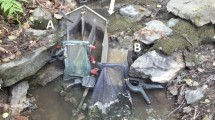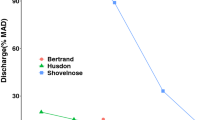Abstract
Amphipods of the infaunal family Haustoriidae are characteristic of high-energy marine sands and occur both in the sediment and the overlying water column. Sediments in this habitat are subject to constant reworking by tidal currents, suggesting that resident amphipod populations are affected by this disturbance in a phenomenon similar to freshwater invertebrate drift. A controlled-velocity laboratory flume was used to examine the effect of haustoriid density, current velocity, illumination, and food availability on drift rates to determine a causal basis for drift. Drift is densityindependent and greatest at night and during high current flow; it is also greater at night from sterile sediment than from untreated sand. Flume transport was usually less than 10% of amphipods present in the sediment. Haustoriids captured downstream were mostly adults occurring in a 1:1 sex ratio, suggesting no obvious function of drift in reproduction. Current-induced displacement of haustoriids may produce the patchiness in distribution observed in nature. Disturbance of the bed could also function to keep amphipod densities below the carrying capacity of the local environment. In certain cases, food limitation may cause amphipods to actively leave the substrate. Under all conditions, greater drift rates in darkness are probably adaptive in avoidance of predators. Despite the nature of sediment movement in a high-energy environment, haustoriid drift may have an active as well as passive component.
Similar content being viewed by others
Literature Cited
Anderson, N. H. and D. M. Lehmkuhl: Catastrophic drift of insects in a woodland stream. Ecology 49, 198–206 (1968)
Bousfield, E. L.: Adaptive radiation in sand burrowing amphipods. Chesapeake Sci. 11, 143–154 (1970)
Bousfield, E. L.: A revised classification and phylogeny of amphipod crustaceans. Trans. R. Soc. Can. 16, 343–390 (1978)
Brongersma-Sanders, M.: Mass mortality in the sea. In: Treatise on marine ecology and paleoecology. Vol. 1. Ecology, pp 941–1010. Ed. by J. W. Hedgpeth. New York: Geological Society of America 1957. (Mem geol. Soc. Am. No. 67)
Byers, S. C., E. L. Mills, and P. L. Stewart: A comparison of methods of determining organic carbon in marine sediments with suggestions for a standard methods. Hydrobiologia 58, 43–48 (1978)
Colman, J. S. and F. Segrove: The tidal plankton over Stoupe Beck Sands, Robin Hood's Bay (Yorkshire, North Riding). J. Anim. Ecol. 24 445–462 (1955)
Conover, W. J.: Practical nonparametric statistics, 462 pp. New York: John Wiley & Sons, Inc. 1971
Corkum, L. D.: Is benthic activity of stream invertebrates related to behavioral drift? Can. J. Zool. 56, 2457–2459 (1978)
Daly, M. A. and A. C. Mathieson: The effects of sand movement on intertidal seaweeds and selected invertebrates at Bound Rock, New Hampshire, USA. Mar. Biol. 43, 45–55 (1977)
Dean, D.: The swimming of bloodworms (Glycera spp.) at night, with comments on other species. Mar. Biol. 48, 99–104 (1978)
Dennell, R.: The habits and feeding mechanisms of the amphipod Haustorius arenarius Slabber. J. Linn. Soc. (Zool.) 38, 363–388 (1933)
Dixon, W. J. and F. J. Massey: Introduction to statistical analysis, 443 pp. New York: McGraw-Hill, Inc. 1969
Fincham, A. A.: Amphipods in the surf plankton. J. mar. biol. Ass. U.K. 50, 177–198 (1970a)
Fincham, A. A.: Rhythmic behaviour of the intertidal amphipod Bathyporeia pelagica. J. mar. biol. Ass. U.K. 50, 1057–1068 (1970b)
Gibson, R. N.: The intertidal movements and distribution of young fish on a sandy beach with special reference to the plaice (Pleuronectes platessa L.). J. exp. mar. Biol. Ecol. 12, 79–102 (1973)
Harms, J. C.: Hydraulic significance of some sand ripples. Bull. geol. Soc. Am. 80, 363–396 (1969)
Harrison, B. J.: The effect of sand ripples on the small-scale distribution of the intertidal meiobenthos with particular reference to harpacticoid copepods. In: Third International Meiofauna Conference, Abstracts, pp 20–21. Ed. by O. Giere. Hamburg, FRG: International Association of Meiobenthologists 1977
Hedgpeth, J. W.: Sandy beaches. In: Treatise on marine ecology and paleoecology. Vol. 1. Ecology, pp 587–608. Ed. by J. W. Hedgpeth. New York: Geological Society of America 1957. (Mem. geol. Soc. Am. No. 67)
Hildebrand, S. G.: The relation of drift to benthos density and food level in an artificial stream. Limnol. Oceanogr. 19, 951–957 (1974)
Holland, A. F. and J. M. Dean: The community biology of intertidal macrofauna inhabiting sandbars in the North Inlet area of South Carolina, U.S.A. In: Ecology of marine benthos, pp 423–438. Ed. by B. C. Coull. Columbia, South Carolina: University of South Carolina Press 1977
Holme, N. A. and A. D. MoIntyre: Methods for the study of marine benthos, 334 pp. Oxford: Blackwell Scientific Publications 1971
Hynes, H. B. N.: The ecology of stream insects. A. Rev. Ent. 15, 25–42 (1970)
Jansson, B. O. and C. Källander: On the diurnal activity of some littoral peracarid crustaceans in the Baltic Sea. J. exp. mar. Biol. Ecol. 2, 24–36 (1968)
Keith, D. E. and N. C. Hulings: A quantitative study of selected nearshore infauna between Sabine Pass and Bolivar Point, Texas, Publs Inst. mar. Sci. Univ. Tex. 10, 33–40 (1965)
King, C. A. M.: Depth of disturbance of sand on sea beaches by waves. J. Sedim. Petrol. 21, 131–140 (1951)
Levin, S. A. and R. T. Paine: Disturbance, patch formation, and community structure. Proc. natn. Acad. Sci. U.S.A. 71, 2744–2747 (1974)
Mills, E. L.: The community concept in marine zoology with comments on continua and stability in some marine communities: a review. J. Fish Res. Bd Can. 26, 1415–1428 (1969)
Müller, K.: Stream drift as a chronobiological phenomenon in running water ecosystems. A. Rev. Ecol. Syst. 5, 309–323 (1974)
Orth, R.J.: Destruction of ellgrass, Zostera marina, by the cownose ray, Rhinoptera bonasus, in the Chesapeake Bay. Chesapeake Sci. 16, 205–298 (1975)
Rhoads, D.C., R. C. Aller and M. B. Goldhaber: The influence of colonizing benthos on physical properties and chemical diagenesis of the estuarine seafloor. In: Ecology of marine benthos, pp 113–138. Ed. by B. C. Coull. Columbia, South Carolina: University of South Carolina Press 1977
Rhodes, W. B.: Distribution of Neohaustorius schmitzi Bousfield (Amphipoda: Haustoriidae) as influenced by physiological tolerances, physical preferences and environmental conditions, 82 pp. M.S. thesis University of South Carolina 1974
Robertson, A. I. and R. K. Howard: Diel trophic interactions between vertically-migrating zooplankton and their fish predators in an eelgrass community. Mar. Biol. 48, 207–213 (1978)
Sameoto, D. D.: Some aspects of the ecology and life cycle of three species of subtidal sand-burrowing amphipods (Crustacea: Haustoriidae). J. Fish. Res. Bd Can. 26, 1321–1345 (1969)
Walton, O. E., Jr., S. R. Reice and R. W. Andrews: The effects of density, sediment particle size and velocity on drift of Acroneuria abnormis (Plecoptera). Oikos 28, 291–298 (1977)
Waters, T. F.: Production rate, population density, and drift of a stream invertebrate. Ecology 47, 595–604 (1966)
Waters, T. F.: The drift of stream insects. A. Rev. Ent. 17, 253–272 (1972)
Watkin, E. E.: Observations on the night tidal migrant Crustacea of Kames Bay. J. mar. biol. Ass. U.K. 25, 81–96 (1941)
Wieser, W.: Factors influencing the choice of substratum in Cumella vulgaris Hart (Crustacea, Cumacea). Limnol. Oceanogr. 1, 274–285 (1956)
Williams, A. B. and K. H. Bynum: A ten year study of meroplankton in North Carolina estuaries: amphipods. Chesapeake Sci. 13, 175–192 (1972)
Woodin, S. A.: Refuges, disturbance and community structure: a marine softbottom example. Ecology 59, 274–284 (1978)
Author information
Authors and Affiliations
Additional information
Communicated by J. M. Lawrence, Tampa
Rights and permissions
About this article
Cite this article
Grant, J. A flume study of drift in marine infaunal amphipods (Haustoriidae). Mar. Biol. 56, 79–84 (1980). https://doi.org/10.1007/BF00390597
Accepted:
Issue Date:
DOI: https://doi.org/10.1007/BF00390597




